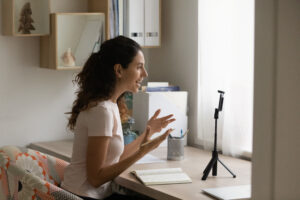Guest Post: Using your cell phone to shoot video for your PR clients
This week I am sharing a blog post courtesy of my PR colleague Jody Fisher, who graciously hosted me on his podcast this month. Read on and enjoy!
Video killed the radio star in 1979, and since then, it’s become indispensable in the PR landscape. Gone are the days of the differences between a print story and a radio story and a TV story. Today, everyone needs video. Yet, getting a TV camera (or multiple cameras) to your press conference or pitched event feels like a magic trick in 2024, with more news to cover and fewer cameras to do it (thanks downsizing). That’s why it’s never been more important for us to be able to shoot, edit and distribute our own video to TV stations and other outlets that want it and use it.
And that part has never been easier. When I was a radio reporter, I added a four-track cassette deck to my field bag, allowing me to record, mix and feed in symphonies of sound. I powered it all from my cigarette lighter in my car, and I thought I was a genius. Today, we each have a TV studio in our pocket: our phones. Using free, pre-loaded apps, anyone can shoot, edit and send usable video to TV stations and other outlets with ease. But success means knowing what assignment editors and producers will use, and how to get it to them. Here are some basic guidelines for shooting great video:
- BROLL and SOTs: BROLL is the video that the TV anchor or reporter talks over, showing the viewer what the script is describing. SOT (Sound on Tape) is the interview soundbytes with your client or someone involved in the story. You should provide at least two, no more than four, SOTs to choose from.
- Plan your shots: Before you hit record, outline the key visuals that will enhance your story. Think about what elements will help convey the message and engage the audience. Shoot a mix of wide, medium, and close-up shots to give editors flexibility in how they use the footage.
- Stabilize your phone: Use a tripod or a gimbal to ensure steady shots. Shaky footage is distracting and unusable. Shoot in at least 1080p to ensure the footage is broadcast-quality.
- Focus on lighting and sound: Outdoor, gentle light works best. If indoors, position your subject near a window or in a well-lit area. Avoid shadows, especially on the face. For sound, find the quietest environment you can, and one that doesn’t distract from the speaker. Camera phones don’t do a great job; invest in a wired, clip-on mic to plug it directly into your phone (my first one cost $20 on Amazon).
Once you’ve captured your B-ROLL and SOTs, you can edit the clips directly on your phone using apps like iMovie or any other free software. Package together with your news release and a description of who is in each SOT and send!
Jody Fisher is Founder & CEO of Jody Fisher PR, based in New York. He represents clients across healthcare, higher ed, non-profit, construction & real estate and more. Connect with him at www.jodyfisherpr.com.

